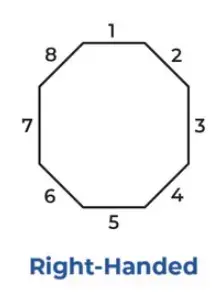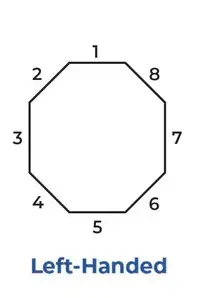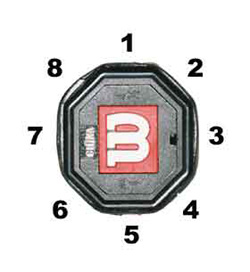A tennis racket handle isn’t round — it’s shaped like an octagon, meaning it has eight flat sides, or bevels. These bevels are the key to understanding how grips work in tennis. When a coach tells you to use a “Continental grip” or “Semi-Western forehand,” what they really mean is: put the base knuckle of your index finger (and usually the heel pad of your hand) on a specific bevel.
Knowing how to identify and feel these bevels is essential for learning, practicing, or correcting your grip. However, when you use Gripsnake, our tennis grip training tool, you don’t really need to worry much about bevels and their numbering. This is because, once positioned correctly, Gripsnake gives your hand tactile feedback, guiding it automatically in the correct positions.
Still, and can be helpful to understand bevels, and even we sometimes use bevel numbers in our instructions.
So, let’s start by breaking down how the bevel numbering system works.
How Bevel Numbering Works (for Right-Handed Players)

Hold your racket out in front of you with the strings perpendicular to the ground, and the face of the racket vertical. Now look at the top edge of the handle — the bevel that’s pointing straight up. That is Bevel 1.
From there, number the bevels clockwise around the handle if you’re right-handed:
-
Bevel 1 – Top bevel (neutral)
-
Bevel 2 – Slightly right of top
-
Bevel 3 – Right side
-
Bevel 4 – Bottom right
-
Bevel 5 – Bottom
-
Bevel 6 – Bottom left
-
Bevel 7 – Left side
-
Bevel 8 – Upper left
This numbering provides a common language across coaching systems.
When someone says “your forehand grip is too Western,” they likely mean your knuckle is landing closer to bevel 5 than bevel 3 or 4.
How Grip Types Align with Bevels
Tennis grips are typically defined by where the base knuckle of the index finger and the heel pad sit on the handle.
For right-handers:
-
Continental Grip – Bevel 2
Used for serves, volleys, slices, overheads, and touch shots. Also for your non-dominant hand in two-handed backhands. -
Eastern Forehand Grip – Bevel 3
Classic but still useful all-court grip, flatter shots. -
Semi-Western Forehand Grip – Bevel 4
Great for topspin and modern baseline play, generates tons of spin. -
Western Forehand Grip – Bevel 5
Generates extreme topspin, closed racket face. Difficult for most players. -
Eastern Backhand (One-Handed) – Bevel 1
Classical backhand, neutral face. -
Semi-Western Backhand (One-Handed) – Bevel 8
A more topspin-heavy backhand.
Two-handed backhands involve both hands on different bevels — for example, dominant hand on bevel 2 (Continental), non-dominant hand on bevel 6 or 7 (mimicking a lefty forehand).
How Bevel Numbering Changes for Left-Handed Players

For left-handed players, the physical shape of the handle doesn’t change, but the bevel numbers rotate in the opposite direction.
Left-handed players number the bevels counter-clockwise, starting from the same Bevel 1 at the top.
So:
-
Bevel 1 – Top (same as righties)
-
Bevel 8 – Right of top
-
Bevel 7 – Right side
-
Bevel 6 – Bottom right
-
Bevel 5 – Bottom
-
Bevel 4 – Bottom left
-
Bevel 3 – Left side
-
Bevel 2 – Upper left
That means if you’re left-handed, the numbers are mirrored in reference to right-handed bevel numbers.
For example, when a right-hander puts their hand on bevel 3 for an Eastern forehand, a left-hander would be on bevel 7 (according to the right-handed bevel numbering system) to achieve the same angle.
This mirroring is why the Gripsnake is available in two different versions, one for right-handed, and one for left-handed players. The placement and angle of the training guides must account for this reverse bevel logic.
Bevel Grips in Practice — Why It Matters
You may be wondering: do bevels really matter that much?
Yes. Most grip-related issues — like mishits, off-center contact, lack of or spin inconsistency, shots that sail long or wide, or sore wrists — come down to gripping the wrong bevel for the stroke you’re attempting. Once you understand where each grip lives on the handle, you can quickly:
-
Diagnose and fix bad habits
-
Understand grip changes between strokes (e.g. serve vs groundstroke)
-
Switch grips faster in live play
- Communicate more clearly with your coach or training partner
And if you’re a coach, bevel knowledge lets you speak a common language across all students — especially when helping left-handed players who often get overlooked in generic grip advice.
Recap: Key Takeaways
-
A tennis racket handle has 8 bevels, numbered clockwise for right-handers, counterclockwise for left-handers.
-
Bevel 1 is always the top bevel when the racket face is perpendicular to the ground.
-
Grips are defined by the position of the index finger’s base knuckle and heel pad on the handle’s bevels.
-
Right-handers: Continental = bevel 2; Eastern = bevel 3; Semi-Western = bevel 4; Western = bevel 5.
-
Left-handers: Continental = bevel 8; Eastern = bevel 7; Semi-Western = bevel 6; Western = bevel 5.
-
Tennis training aids like Gripsnake are designed to reinforce the correct bevel usage for both left- and right-handers.

